
Unified Combatant Command
Encyclopedia
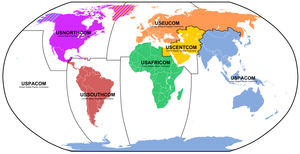
United States Department of Defense
The United States Department of Defense is the U.S...
command
Command (military formation)
A command in military terminology is an organisational unit that the individual in Military command has responsibility for. A Commander will normally be specifically appointed into the role in order to provide a legal framework for the authority bestowed...
that is composed of forces from at least two Military Departments and has a broad and continuing mission. These commands are established to provide effective command and control of U.S. military forces, regardless of branch of service, in peace and war. They are organized either on a geographical basis (known as "Area of Responsibility
Area of responsibility
Area Of Responsibility is a pre-defined geographic region assigned to a Combatant commanders of the Unified Command Plan , that are used to define an area with specific geographic boundaries where they have the authority to plan and conduct operations; for which a force, or component commander...
", AOR) or on a functional basis. UCCs are "joint" commands with specific badges denoting their affiliation.
The Unified Command Plan (UCP) is updated annually in conjunction with the DoD Fiscal Year and can modify areas of responsibility or combatant command alignments or assignments. As of September 2011, there are nine Unified Combatant Commands as specified in Title 10 and the latest annual UCP. Six have regional responsibilities, and three have functional responsibilities.
Each unified command is led by a Combatant Commander (CCDR), who is a four-star general
General (United States)
In the United States Army, United States Air Force, and United States Marine Corps, general is a four-star general officer rank, with the pay grade of O-10. General ranks above lieutenant general and below General of the Army or General of the Air Force; the Marine Corps does not have an...
or admiral
Admiral (United States)
In the United States Navy, the United States Coast Guard and the United States Public Health Service Commissioned Corps, admiral is a four-star flag officer rank, with the pay grade of O-10. Admiral ranks above vice admiral and below Fleet Admiral in the Navy; the Coast Guard and the Public Health...
. CCDRs exercise combatant command (COCOM), a specific type of nontransferable command authority over assigned forces, regardless of branch of service, that is vested only in the CCDRs by federal law in . The Chain of Command for operational purposes (as per the Goldwater–Nichols Act) goes from the President
President of the United States
The President of the United States of America is the head of state and head of government of the United States. The president leads the executive branch of the federal government and is the commander-in-chief of the United States Armed Forces....
through the Secretary of Defense
United States Secretary of Defense
The Secretary of Defense is the head and chief executive officer of the Department of Defense of the United States of America. This position corresponds to what is generally known as a Defense Minister in other countries...
to the Combatant Commanders.
History
The current system of unified commands in the US military emerged during World War IIWorld War II
World War II, or the Second World War , was a global conflict lasting from 1939 to 1945, involving most of the world's nations—including all of the great powers—eventually forming two opposing military alliances: the Allies and the Axis...
with the establishment of geographic theaters of operation composed of forces from multiple service branches that reported to a single commander who was supported by a joint staff. A unified command structure also existed to coordinate British and American military forces operating under the Combined Chiefs of Staff
Combined Chiefs of Staff
The Combined Chiefs of Staff was the supreme military command for the western Allies during World War II. It was a body constituted from the British Chiefs of Staff Committee and the American Joint Chiefs of Staff....
, which was composed the British Chiefs of Staff Committee
Chiefs of Staff Committee
The Chiefs of Staff Committee is composed of the most senior military personnel in the British Armed Forces.-History:The Chiefs of Staff Committee was initially established as a sub-committee of the Committee of Imperial Defence in 1923. It remained as such until the abolition of the CID upon the...
and the American Joint Chiefs of Staff
Joint Chiefs of Staff
The Joint Chiefs of Staff is a body of senior uniformed leaders in the United States Department of Defense who advise the Secretary of Defense, the Homeland Security Council, the National Security Council and the President on military matters...
. In the European Theater
European Theatre of World War II
The European Theatre of World War II was a huge area of heavy fighting across Europe from Germany's invasion of Poland on September 1, 1939 until the end of the war with the German unconditional surrender on May 8, 1945...
, Allied military forces fell under the command of the Supreme Headquarters Allied Expeditionary Force
Supreme Headquarters Allied Expeditionary Force
Supreme Headquarters Allied Expeditionary Force , was the headquarters of the Commander of Allied forces in north west Europe, from late 1943 until the end of World War II. U.S. General Dwight D. Eisenhower was in command of SHAEF throughout its existence...
(SHAEF). After SHAEF was dissolved at the end of the war, the American forces were unified under a single command, the US Forces, European Theater (USFET), commanded by General of the Army
General of the Army (United States)
General of the Army is a five-star general officer and is the second highest possible rank in the United States Army. A special rank of General of the Armies, which ranks above General of the Army, does exist but has only been conferred twice in the history of the Army...
Dwight D. Eisenhower
Dwight D. Eisenhower
Dwight David "Ike" Eisenhower was the 34th President of the United States, from 1953 until 1961. He was a five-star general in the United States Army...
. Unified commands in the Pacific Theater
Pacific War
The Pacific War, also sometimes called the Asia-Pacific War refers broadly to the parts of World War II that took place in the Pacific Ocean, its islands, and in East Asia, then called the Far East...
proved more difficult to organize as neither General of the Army Douglas MacArthur
Douglas MacArthur
General of the Army Douglas MacArthur was an American general and field marshal of the Philippine Army. He was a Chief of Staff of the United States Army during the 1930s and played a prominent role in the Pacific theater during World War II. He received the Medal of Honor for his service in the...
nor Fleet Admiral Chester W. Nimitz were willing to become subordinate to the other. Nevertheless, the Joint Chiefs of Staff continued to advocate in favor of establishing permanent unified commands, and President Harry S. Truman
Harry S. Truman
Harry S. Truman was the 33rd President of the United States . As President Franklin D. Roosevelt's third vice president and the 34th Vice President of the United States , he succeeded to the presidency on April 12, 1945, when President Roosevelt died less than three months after beginning his...
approved the first plan on 14 December 1946. Known as the "Outline Command Plan," it would become the first in a series of Unified Command Plans.
Although not part of the original plan, the Joint Chiefs of Staff
Joint Chiefs of Staff
The Joint Chiefs of Staff is a body of senior uniformed leaders in the United States Department of Defense who advise the Secretary of Defense, the Homeland Security Council, the National Security Council and the President on military matters...
(JCS) also created specified commands that had broad and continuing missions but were composed of forces from only one service. Examples include the U.S. Naval Forces, Eastern Atlantic and Mediterranean and the US Air Force's Strategic Air Command. Like the unified commands, the specified commands reported directly to the JCS instead of their respective service chiefs. Although these commands have not existed since the Strategic Air Command was disestablished in 1992, federal law still contains a provision authorizing the President to establish a new specified command.
Under the original plan, each of the unified commands operated with one of the service chiefs (the Chief of Staff of the Army
Chief of Staff of the United States Army
The Chief of Staff of the Army is a statutory office held by a four-star general in the United States Army, and is the most senior uniformed officer assigned to serve in the Department of the Army, and as such is the principal military advisor and a deputy to the Secretary of the Army; and is in...
or Air Force
Chief of Staff of the United States Air Force
The Chief of Staff of the Air Force is a statutory office held by a four-star general in the United States Air Force, and is the most senior uniformed officer assigned to serve in the Department of the Air Force, and as such is the principal military advisor and a deputy to the Secretary of the...
, or the Chief of Naval Operations
Chief of Naval Operations
The Chief of Naval Operations is a statutory office held by a four-star admiral in the United States Navy, and is the most senior uniformed officer assigned to serve in the Department of the Navy. The office is a military adviser and deputy to the Secretary of the Navy...
) serving as an executive agent representing the Joint Chiefs of Staff. This arrangement was formalized on 21 April 1948 as part of a policy paper titled the "Function of the Armed Forces and the Joint Chiefs of Staff" (informally known as the "Key West Agreement
Key West Agreement
The Key West Agreement is the colloquial name for the policy paper Function of the Armed Forces and the Joint Chiefs of Staff drafted by James V. Forrestal, the first United States Secretary of Defense...
"). The responsibilities of the unified commands were further expanded on 7 September 1948 when the commanders' authority was extended to include the coordination of the administrative and logistical functions in addition to their combat responsibilities.
The Goldwater-Nichols Defense Reorganization Act
Goldwater-Nichols Act
The Goldwater-Nichols Department of Defense Reorganization Act of 1986 , , made the most sweeping changes to the United States Department of Defense since the department was established in the National Security Act of 1947 by reworking the command structure of the United States military...
of 1986 clarified and codified responsibilities that commanders-in-chief (CINCs) and their predecessors (theater or area commanders) had undertaken since World War II, and which were first given legal status in 1947.
The U.S. Atlantic Command became the Joint Forces Command
United States Joint Forces Command
United States Joint Forces Command was a former Unified Combatant Command of the United States Armed Forces. USJFCOM was a functional command that provided specific services to the military. The last commander was Army Gen. Raymond T. Odierno...
in the 1990s after the Soviet threat to the North Atlantic had disappeared and the need rose for an integrating and experimentation command for forces in the continental United States. The Joint Forces Command
United States Joint Forces Command
United States Joint Forces Command was a former Unified Combatant Command of the United States Armed Forces. USJFCOM was a functional command that provided specific services to the military. The last commander was Army Gen. Raymond T. Odierno...
was disbanded on August 3, 2011 and its components placed under the Joint Staff and other Combatant Commands.
Regional CINCs were created in order to have a local supreme commander who could exercise unified command and control across service boundaries, ideally eliminating or diminishing interservice rivalries. CINCs reported directly to the United States Secretary of Defense, and through him to the President of the United States. One of the best known CINCs was Norman Schwarzkopf, commander of U.S. Central Command (CENTCOM) during Operation Desert Storm.
On 24 October 2002, Secretary of Defense Donald H. Rumsfeld announced that in accordance with Title 10
Title 10 of the United States Code
Title 10 of the United States Code outlines the role of armed forces in the United States Code.It provides the legal basis for the roles, missions and organization of each of the services as well as the United States Department of Defense...
of the US Code (USC), the title of "Commander-in-Chief" would thereafter be reserved for the President, consistent with the terms of Article II of the United States Constitution
United States Constitution
The Constitution of the United States is the supreme law of the United States of America. It is the framework for the organization of the United States government and for the relationship of the federal government with the states, citizens, and all people within the United States.The first three...
. Thereafter, the military CINCs would be known as "combatant commanders", as heads of the Unified Combatant Commands.
The sixth geographical combatant command for Africa (USAFRICOM
United States Africa Command
The United States Africa Command is one of nine Unified Combatant Commands of the United States Armed Forces, headquartered at Kelley Barracks, Stuttgart, Germany. It is responsible for U.S. military operations and military relations with 53 African nations – an area of responsibility covering all...
) was approved and established in 2007. It operated under U.S. European Command during its first year. It transitioned to independent Unified Command Status October 2008. In 2009, it focused on synchronizing hundreds of activities inherited from three regional commands that previously coordinated U.S. military relations in Africa.
Current
| Emblem | Command | Acronym | Role | Established | Headquarters |
|---|---|---|---|---|---|
| United States Africa Command United States Africa Command The United States Africa Command is one of nine Unified Combatant Commands of the United States Armed Forces, headquartered at Kelley Barracks, Stuttgart, Germany. It is responsible for U.S. military operations and military relations with 53 African nations – an area of responsibility covering all... |
USAFRICOM | Geographic | 2007-10-01 | Kelley Barracks Kelley Barracks thumb|U.S. Africa Command HQ.Kelley Barracks is a U.S. military installation in Stuttgart-Möhringen in Germany.Located ten miles southeast of Stuttgart, Kelley Barracks was built in 1938 and was known by the German Army as Hellenen Kaserne. Shortly after the end of World War II it was renamed in... , Germany Germany Germany , officially the Federal Republic of Germany , is a federal parliamentary republic in Europe. The country consists of 16 states while the capital and largest city is Berlin. Germany covers an area of 357,021 km2 and has a largely temperate seasonal climate... |
|
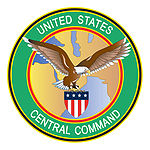 |
United States Central Command United States Central Command The United States Central Command is a theater-level Unified Combatant Command unit of the U.S. armed forces, established in 1983 under the operational control of the U.S. Secretary of Defense... |
USCENTCOM | Geographic | 1983-01-01 | MacDill Air Force Base MacDill Air Force Base MacDill Air Force Base is an active United States Air Force base located approximately south-southwest of downtown Tampa, Florida... , Florida Florida Florida is a state in the southeastern United States, located on the nation's Atlantic and Gulf coasts. It is bordered to the west by the Gulf of Mexico, to the north by Alabama and Georgia and to the east by the Atlantic Ocean. With a population of 18,801,310 as measured by the 2010 census, it... |
| United States European Command United States European Command The United States European Command is one of ten Unified Combatant Commands of the United States military, headquartered in Stuttgart, Germany. Its area of focus covers and 51 countries and territories, including Europe, Russia, Iceland, Greenland, and Israel... |
USEUCOM | Geographic | 1947-03-15 | Patch Barracks Patch Barracks Patch Barracks is a well-known US military installation in Stuttgart-Vaihingen in Germany. It is named after Alexander M. Patch.Patch Barracks was renamed from the German Kurmärker Kaserne in 1952; it was originally built for use by the German Army Wehrmacht in 1936/37... , Germany Germany Germany , officially the Federal Republic of Germany , is a federal parliamentary republic in Europe. The country consists of 16 states while the capital and largest city is Berlin. Germany covers an area of 357,021 km2 and has a largely temperate seasonal climate... |
|
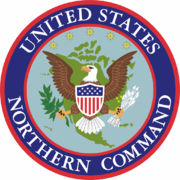 |
United States Northern Command United States Northern Command United States Northern Command is a Unified Combatant Command of the United States military. Created on 1 October 2002 in the aftermath of the 11 September 2001 attacks, its mission is to protect the United States homeland and support local, state, and federal authorities... |
USNORTHCOM | Geographic | 2002-10-01 | Peterson Air Force Base Peterson Air Force Base Peterson Air Force Base is a base of the United States Air Force located at Colorado Springs in El Paso County, Colorado, United States and it provides runways for the adjacent City of Colorado Springs Municipal Airport under a shared joint civil-military airport arrangement... , Colorado Colorado Colorado is a U.S. state that encompasses much of the Rocky Mountains as well as the northeastern portion of the Colorado Plateau and the western edge of the Great Plains... |
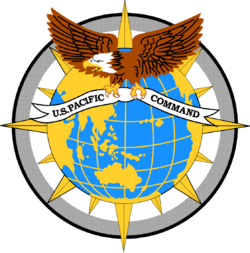 |
United States Pacific Command United States Pacific Command The United States Pacific Command is a Unified Combatant Command of the United States armed forces responsible for the Pacific Ocean area. It is led by the Commander, Pacific Command , who is the supreme military authority for the various branches of the Armed Forces of the United States serving... |
USPACOM | Geographic | 1947-01-01 | Camp H. M. Smith Camp H. M. Smith Camp H. M. Smith is a United States Marine Corps installation in the Hawaiian town of Aiea on the island of Oahu, near the community of Halawa Heights... , Hawaii Hawaii Hawaii is the newest of the 50 U.S. states , and is the only U.S. state made up entirely of islands. It is the northernmost island group in Polynesia, occupying most of an archipelago in the central Pacific Ocean, southwest of the continental United States, southeast of Japan, and northeast of... |
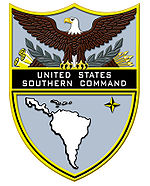 |
United States Southern Command United States Southern Command The United States Southern Command , located in Miami, Florida, is one of nine Unified Combatant Commands in the United States Department of Defense. It is responsible for providing contingency planning and operations in Central and South America, the Caribbean The United States Southern Command... |
USSOUTHCOM | Geographic | 1963-06-06 | Miami, Florida Florida Florida is a state in the southeastern United States, located on the nation's Atlantic and Gulf coasts. It is bordered to the west by the Gulf of Mexico, to the north by Alabama and Georgia and to the east by the Atlantic Ocean. With a population of 18,801,310 as measured by the 2010 census, it... |
| United States Special Operations Command United States Special Operations Command The United States Special Operations Command is the Unified Combatant Command charged with overseeing the various Special Operations Commands of the Army, Air Force, Navy and Marine Corps of the United States Armed Forces. The command is part of the Department of Defense... |
USSOCOM | Functional | 1987-04-16 | MacDill Air Force Base MacDill Air Force Base MacDill Air Force Base is an active United States Air Force base located approximately south-southwest of downtown Tampa, Florida... , Florida Florida Florida is a state in the southeastern United States, located on the nation's Atlantic and Gulf coasts. It is bordered to the west by the Gulf of Mexico, to the north by Alabama and Georgia and to the east by the Atlantic Ocean. With a population of 18,801,310 as measured by the 2010 census, it... |
|
| United States Strategic Command United States Strategic Command United States Strategic Command is one of nine Unified Combatant Commands of the United States Department of Defense . The Command, including components, employs more than 2,700 people, representing all four services, including DoD civilians and contractors, who oversee the command's operationally... |
USSTRATCOM | Functional | 1992-06-01 | Offutt Air Force Base Offutt Air Force Base Offutt Air Force Base is a U.S. Air Force installation near Omaha, and lies adjacent to Bellevue in Sarpy County, Nebraska. It is the headquarters of the U.S... , Nebraska Nebraska Nebraska is a state on the Great Plains of the Midwestern United States. The state's capital is Lincoln and its largest city is Omaha, on the Missouri River.... |
|
| United States Transportation Command United States Transportation Command The United States Transportation Command is one of nine unified commands of the United States Department of Defense. The mission of USTRANSCOM is to provide air, land and sea transportation for the Department of Defense, both in time of peace and time of war.USTRANSCOM, located at Scott Air Force... |
USTRANSCOM | Functional | 1987-07-01 | Scott Air Force Base Scott Air Force Base Scott Air Force Base is a base of the United States Air Force in St. Clair County, Illinois, near Belleville.-Overview:The base is named after Corporal Frank S. Scott, the first enlisted person to be killed in an aviation crash... , Illinois Illinois Illinois is the fifth-most populous state of the United States of America, and is often noted for being a microcosm of the entire country. With Chicago in the northeast, small industrial cities and great agricultural productivity in central and northern Illinois, and natural resources like coal,... |
Former
Since the first Unified Command Plan was approved on 14 December 1946, several unified and specific combatant commands have been established and disestablished. Some of the commands existed before they were officially established as unified or specified commands, or continued to exist after they were disestablished.| Emblem | Command | Acronym | Type | Established | Disestablished | Comments |
|---|---|---|---|---|---|---|
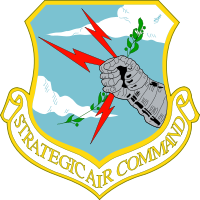 |
Strategic Air Command Strategic Air Command The Strategic Air Command was both a Major Command of the United States Air Force and a "specified command" of the United States Department of Defense. SAC was the operational establishment in charge of America's land-based strategic bomber aircraft and land-based intercontinental ballistic... |
SAC | Specified | 1946-12-14 | 1992-05-31 | Duties assumed by USSTRATCOM |
 |
Alaska Command | ALCOM | Unified | 1947-01-01 | 1975-06-30 | Became part of USPACOM |
| Far East Command | FECOM | Unified | 1947-01-01 | 1957-07-01 | Became part of USPACOM | |
| Caribbean Command | CARIBCOM | Unified | 1947-11-01 | 1963-06-06 | Replaced by USSOUTHCOM | |
| U.S. Naval Forces, Eastern Atlantic and Mediterranean | NELM | Specified | 1947-11-01 | 1963-12-01 | Became part of USEUCOM | |
| Atlantic Command United States Atlantic Command United States Atlantic Command was a Unified Combatant Command of the United States Department of Defense. In 1999, U.S. Atlantic Command was renamed and given a new mission as United States Joint Forces Command.-History:USLANTCOM was active from the 1947 to 1993 as a primarily U.S... |
LANTCOM | Unified | 1947-12-01 | 1999-09-31 | Replaced by USJFCOM | |
| US Northeast Command | USNEC | Unified | 1950-10-01 | 1956-09-01 | ||
| US Air Forces, Europe United States Air Forces in Europe The United States Air Forces in Europe is the United States Air Force component of U.S. European Command, a Department of Defense unified command, and is one of two Air Force Major Commands outside of the continental United States, the other being the Pacific Air Forces... |
USAFE | Specified | 1951-01-22 | 1956-07-01 | Became part of USEUCOM | |
| Continental Air Defense Command | CONAD | Unified | 1954-09-01 | 1975-06-30 | Replaced by ADCOM | |
| US Strike Command United States Strike Command In 1961 the United States Strike Command was established at MacDill Air Force Base as a unified combatant command capable of responding to global crises. The name of the command was originally derived from the acronym for Swift Tactical Reaction In Every Known Environment... |
USSTRICCOM | Unified | 1962-01-01 | 1971-12-31 | Reorganized as USREDCOM | |
| Aerospace Defense Command Aerospace Defense Command Aerospace Defense Command is an inactive United States Air Force Major Command. Established in 1946 under the United States Army Air Forces, its mission was to organize and administer the integrated air defense system of the Continental United States , exercise direct control of all active... |
ADCOM | Specified | 1975-07-01 | 1979-10-01 | Duties assumed by Air Defense, Tactical Air Command (ADTAC) | |
| US Readiness Command | USREDCOM | Unified | 1972-01-01 | 1987-04-15 | Replaced by USSOCOM | |
| Military Airlift Command Military Airlift Command The Military Airlift Command is an inactive United States Air Force Major Command of the USAF which was headquartered at Scott Air Force Base, Illinois. It was constituted on 1 January 1966 and active until the end of the Cold War, when the Air Force table of organization was revised... |
MAC | Specified | 1977-02-01 | 1987-07-01 | Duties as a specified command assumed by USTRANSCOM; later replaced by Air Mobility Command Air Mobility Command Air Mobility Command is a Major Command of the U.S. Air Force. AMC is headquartered at Scott AFB, Illinois, east of St. Louis.... in 1992 |
|
| US Space Command United States Space Command The United States Space Command was a Unified Combatant Command of the United States Department of Defense, created in 1985 to help institutionalize the use of outer space by the United States Armed Forces. The Commander in Chief of U.S... |
USSPACECOM | Unified | 1985-09-23 | 2002-10-01 | Duties assumed by USSTRATCOM | |
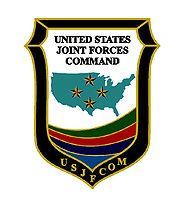 |
United States Joint Forces Command United States Joint Forces Command United States Joint Forces Command was a former Unified Combatant Command of the United States Armed Forces. USJFCOM was a functional command that provided specific services to the military. The last commander was Army Gen. Raymond T. Odierno... |
USJFCOM | Unified | 1999-10-01 | 2011-09-03 | Duties assumed by the Joint Staff and various other Combatant Commands |
Combatant Commanders
Each combatant command is headed by a four-star general or admiral recommended by the Secretary of Defense, nominated by the President, confirmed by Congress and appointed by the President. The Goldwater-Nichols Act and its subsequent implementation legislation also resulted in specific Joint Professional Military EducationJoint Professional Military Education
Joint Professional Military Education is a form of Professional Military Education in the United States that emphasizes a multiservice approach. Joint Professional Military Education was established following greater awareness during World War II of a need for effective cooperation between the...
(JPME) requirements for officers before they could attain flag or general officer rank thereby preparing them for duty in Joint assignments such as UCC staff or Joint Chiefs of Staff assignments, which are strictly controlled tour length rotations of duty. However, in the decades following enactment of Goldwater-Nichols, these JPME requirements have yet to come to overall fruition. This is particularly true in the case of senior naval officers, where sea duty/shore duty rotations and the culture of the naval service has often discounted PME and JPME as a measure of professional development for success. Although slowly changing, the JPME requirement still continues to be frequently waived in the case of senior admirals nominated for these positions.
The operational chain of command runs from the President
President of the United States
The President of the United States of America is the head of state and head of government of the United States. The president leads the executive branch of the federal government and is the commander-in-chief of the United States Armed Forces....
to the Secretary of Defense
United States Secretary of Defense
The Secretary of Defense is the head and chief executive officer of the Department of Defense of the United States of America. This position corresponds to what is generally known as a Defense Minister in other countries...
to the combatant commanders of the Combatant Commands. The Chairman of the Joint Chiefs of Staff
Chairman of the Joint Chiefs of Staff
The Chairman of the Joint Chiefs of Staff is by law the highest ranking military officer in the United States Armed Forces, and is the principal military adviser to the President of the United States, the National Security Council, the Homeland Security Council and the Secretary of Defense...
may transmit communications to the Commanders of the Combatant Commands from the President and Secretary of Defense and advises both on potential courses of action, but the Chairman does not exercise military command over any combatant forces. Under Goldwater-Nichols, the service chiefs (also four stars in rank) are charged with the responsibility of the "strategic direction, unified operation of combatant commands, and the integration of all land, naval, and air forces in an efficient "unified combatant command" force. Furthermore, the Secretaries of the Military Departments (i.e. Secretary of the Army
United States Secretary of the Army
The Secretary of the Army is a civilian official within the Department of Defense of the United States of America with statutory responsibility for all matters relating to the United States Army: manpower, personnel, reserve affairs, installations, environmental issues, weapons systems and...
, Secretary of the Navy
United States Secretary of the Navy
The Secretary of the Navy of the United States of America is the head of the Department of the Navy, a component organization of the Department of Defense...
, and the Secretary of the Air Force
United States Secretary of the Air Force
The Secretary of the Air Force is the Head of the Department of the Air Force, a component organization within the Department of Defense of the United States of America. The Secretary of the Air Force is appointed from civilian life by the President, by and with the advice and consent of the Senate...
) are legally responsible to "organize, train and equip" combatant forces and, as directed by the Secretary of Defense, assign their forces for use by the combatant commands. The Secretaries of the Military Departments also do not exercise any operational control over their forces.
Each combatant command can be led by a general or flag officer
Flag Officer
A flag officer is a commissioned officer in a nation's armed forces senior enough to be entitled to fly a flag to mark where the officer exercises command. The term usually refers to the senior officers in an English-speaking nation's navy, specifically those who hold any of the admiral ranks; in...
from any of the military services. Most commands have traditional service affiliations, but in recent years, non-traditional appointments have become more common. EUCOM was traditionally an Army command with USAF generals on occasion, but was held by a Marine from 2003 through 2006. CENTCOM was traditionally an Army and Marine command but William J. Fallon
William J. Fallon
William Joseph Fallon is a retired United States Navy four-star admiral who retired after serving for over 41 years. His last military assignment was as Commander, U.S. Central Command from March 2007 to March 2008. ADM Fallon was the first Navy officer to hold that position. His other four-star...
, commander from 2007 through 2008, was a Navy admiral. PACOM has always been commanded by a Navy admiral due to the wide expanse of ocean, although Air Force generals have been nominated for the post. U.S. Atlantic Command (USACOM) was also a traditional Navy assignment until it was successively commanded by Marine, Army, and Air Force generals, thereby becoming the first to have had commanders from all four services (USACOM was redesignated as JFCOM in 1999). CENTCOM and SOUTHCOM were traditionally Army general positions until the Marines received their first CinC assignments. This led the way for General Pace
Peter Pace
Peter Pace is a retired United States Marine Corps general who served as the 16th Chairman of the Joint Chiefs of Staff, the first Marine appointed to the United States' highest-ranking military office. Appointed by President George W. Bush, Pace succeeded U.S. Air Force General Richard Myers on...
to become the first Vice Chairman of the Joint Chiefs of Staff
Vice Chairman of the Joint Chiefs of Staff
The Vice Chairman of the Joint Chiefs of Staff is by law the second highest ranking military officer in the United States Armed Forces ranking just below the Chairman of the Joint Chiefs of Staff...
and ultimately Chairman from the Marine Corps. CCDRs are strong candidates for either position.
Other changes and proposals
At some points, there have been proposals to create some sort of Reserve Affairs Worldwide Support command for the Reserve and National Guard of the United States. Also considered was the United States Medical CommandUnited States Unified Medical Command
The United States Unified Medical Command was a proposed Unified Combatant Command within the United States Department of Defense. The plan was rejected in December 2006 due to heavy resistance from Air Force Surgeon General Lieutenant General James G...
which was proposed but then abandoned.
External links
- Interactive Map - US Africa Command (USAFRICOM) area of operation from the United States Army AfricaUnited States Army AfricaUnited States Army Africa , formerly known as the Southern European Task Force ', is the United States Army component command of United States Africa Command...
- Unified Command Plan Department of Defense
- Unified Command Plan GlobalSecurity.org

